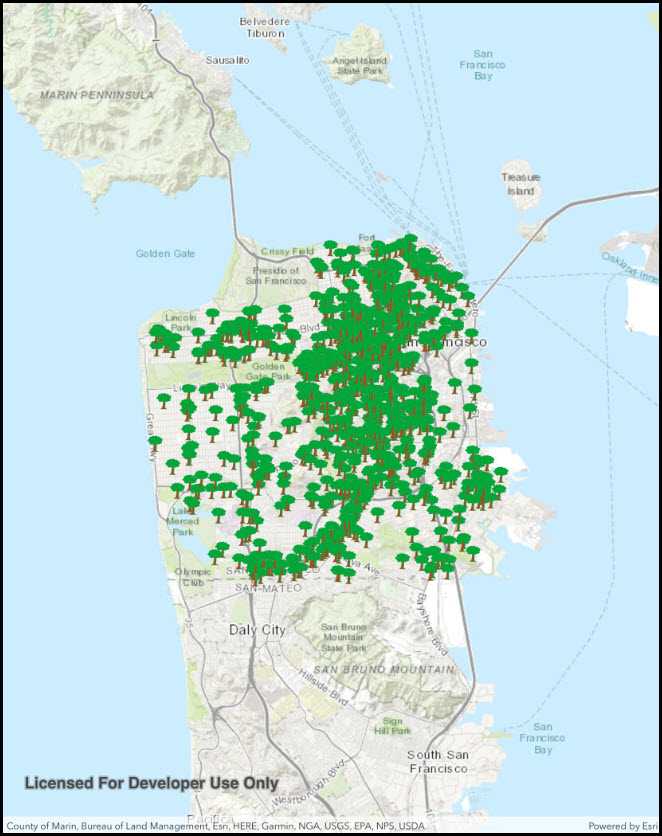Display a feature layer from a service using the manual cache feature request mode.

Use case
ServiceFeatureTable supports three request modes, which define how features are requested from the service and stored in the local table. The feature request modes have different performance characteristics. Use manual cache in scenarios where you want to explicitly control requests for features.
How to use the sample
Run the sample and pan and zoom around the map. Observe the features loaded from the table.
How it works
- Set the
ServiceFeatureTable.FeatureRequestModeproperty of the service feature table toManualCachebefore the table is loaded. - Load the table.
- Call
PopulateFromServiceAsyncon the table to request features.
Relevant API
- FeatureLayer
- FeatureRequestMode.ManualCache
- ServiceFeatureTable
- ServiceFeatureTable.PopulateFromServiceAsync
- ServiceFeatureTable.FeatureRequestMode
About the data
The sample uses a feature service showing pool permits for land parcels in a Riverside, CA neighborhood.
Additional information
In manual cache mode, features are never automatically populated from the service. All features are loaded manually using calls to PopulateFromServiceAsync.
Tags
cache, feature request mode, performance
Sample Code
// Copyright 2016 Esri.
//
// Licensed under the Apache License, Version 2.0 (the "License"); you may not use this file except in compliance with the License.
// You may obtain a copy of the License at: http://www.apache.org/licenses/LICENSE-2.0
//
// Unless required by applicable law or agreed to in writing, software distributed under the License is distributed on an
// "AS IS" BASIS, WITHOUT WARRANTIES OR CONDITIONS OF ANY KIND, either express or implied. See the License for the specific
// language governing permissions and limitations under the License.
using Esri.ArcGISRuntime.Data;
using Esri.ArcGISRuntime.Geometry;
using Esri.ArcGISRuntime.Mapping;
using Esri.ArcGISRuntime.UI.Controls;
using Foundation;
using System;
using UIKit;
namespace ArcGISRuntime.Samples.ServiceFeatureTableManualCache
{
[Register("ServiceFeatureTableManualCache")]
[ArcGISRuntime.Samples.Shared.Attributes.Sample(
name: "Service feature table (manual cache)",
category: "Data",
description: "Display a feature layer from a service using the **manual cache** feature request mode.",
instructions: "Run the sample and pan and zoom around the map. Observe the features loaded from the table.",
tags: new[] { "cache", "feature request mode", "performance" })]
public class ServiceFeatureTableManualCache : UIViewController
{
// Hold references to UI controls.
private MapView _myMapView;
// Hold a reference to the service feature table.
private ServiceFeatureTable _incidentsFeatureTable;
public ServiceFeatureTableManualCache()
{
Title = "Service feature table (manual cache)";
}
private void Initialize()
{
// Create new Map with basemap.
Map myMap = new Map(BasemapStyle.ArcGISTopographic);
// Create and set initial map location.
MapPoint initialLocation = new MapPoint(-13630484, 4545415, SpatialReferences.WebMercator);
myMap.InitialViewpoint = new Viewpoint(initialLocation, 500000);
// Create URL to the used feature service.
Uri serviceUri = new Uri("https://sampleserver6.arcgisonline.com/arcgis/rest/services/SF311/FeatureServer/0");
// Create feature table for the incident feature service.
_incidentsFeatureTable = new ServiceFeatureTable(serviceUri)
{
// Define the request mode.
FeatureRequestMode = FeatureRequestMode.ManualCache
};
// When feature table is loaded, populate data.
_incidentsFeatureTable.Loaded += OnLoadedPopulateData;
// Create FeatureLayer that uses the created table.
FeatureLayer incidentsFeatureLayer = new FeatureLayer(_incidentsFeatureTable);
// Add created layer to the map.
myMap.OperationalLayers.Add(incidentsFeatureLayer);
// Assign the map to the MapView.
_myMapView.Map = myMap;
}
private async void OnLoadedPopulateData(object sender, EventArgs e)
{
// Unsubscribe from event.
_incidentsFeatureTable.Loaded -= OnLoadedPopulateData;
// Create new query object that contains parameters to query specific request types.
QueryParameters queryParameters = new QueryParameters
{
WhereClause = "req_Type = 'Tree Maintenance or Damage'"
};
// Create list of the fields that are returned from the service.
string[] outputFields = {"*"};
try
{
// Populate feature table with the data based on query.
await _incidentsFeatureTable.PopulateFromServiceAsync(queryParameters, true, outputFields);
}
catch (Exception ex)
{
new UIAlertView("Error", ex.ToString(), (IUIAlertViewDelegate) null, "OK", null).Show();
}
}
public override void ViewDidLoad()
{
base.ViewDidLoad();
Initialize();
}
public override void LoadView()
{
// Create the views.
_myMapView = new MapView();
_myMapView.TranslatesAutoresizingMaskIntoConstraints = false;
View = new UIView() { BackgroundColor = ApplicationTheme.BackgroundColor };
// Add the views.
View.AddSubviews(_myMapView);
// Lay out the views.
NSLayoutConstraint.ActivateConstraints(new[]
{
_myMapView.TopAnchor.ConstraintEqualTo(View.SafeAreaLayoutGuide.TopAnchor),
_myMapView.BottomAnchor.ConstraintEqualTo(View.BottomAnchor),
_myMapView.LeadingAnchor.ConstraintEqualTo(View.LeadingAnchor),
_myMapView.TrailingAnchor.ConstraintEqualTo(View.TrailingAnchor)
});
}
}
}